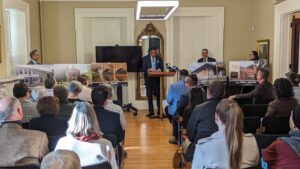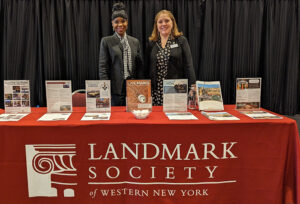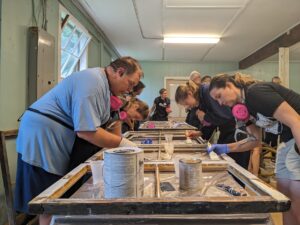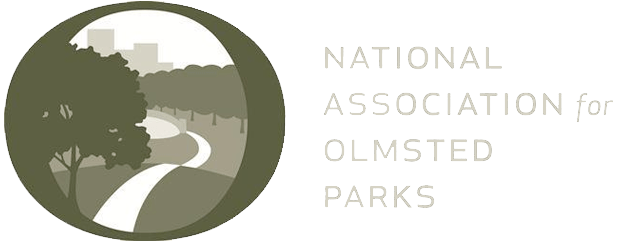
We’re not just saving buildings – we’re saving the world!
- June 8, 2009
- 7:45 pm
- June 8, 2009
- 7:45 pm
 “Existing buildings are going to be what saves the world.” -Jean Carroon, June 4, 2009
“Existing buildings are going to be what saves the world.” -Jean Carroon, June 4, 2009
On Thursday, June 4, over 85 preservationists, architects, engineers, planners, facilities managers, and others gathered in the Eisenhart Auditorium at the Rochester Museum & Science Center to learn how and why to improve the energy performance of historic buildings. Jean Carroon, FAIA, LEED, Principal for Preservation at Goody Clancy in Boston, shared her years of experience exploring ways to pair sustainability and preservation.
The day-long workshop was a good news-bad news situation.
The bad news? Climate change is a huge problem, with new evidence coming out to show the impacts of human activity on our planet are even worse that scientists thought just a few years ago. As often as I’ve heard about or read the statistics on this, it gives me chills every time I see the stark images of melting glaciers that point to accelerating, dramatic change. The construction and operation of buildings, as Jean said (and as I say in my own presentations on this topic), is a huge source of carbon dioxide emissions.
The good news? Because buildings are such a problem now, they also represent a tremendous opportunity to make changes – and any historic building’s energy performance can be improved.
But, back to a little bad news. Many of the things that are being promoted as “the solution” – new “green” products, McMansions with lower energy bills, or – ack! – replacement windows – are ineffective or, worse, have the opposite effect of what they’re supposed to. Many so-called “green” products may improve a building’s energy performance, or have recycled components, or whatever, but given the full life cycle of those products – the way they were made, how they were transported, their long-term effect on the health of the building and its occupants (keep in mind, asbestos was once a miracle product touted for its energy-saving potential), it is likely that few of these new products are all they’re cracked up to be, and some may even have very negative unintended consequences for human and/or building health in the long run. Not to mention the many problems with building new “green” buildings to try to stave off climate change; of course new buildings should be green, but in many cases, reuse of an existing building is a much more sustainable solution.
Now back to the bright side. The most important things that we can do to reduce our personal carbon footprints are good for historic buildings! Insulating attics and basements, installing programmable thermostats (and setting the temperature on the low side in winter, high in summer), washing clothes in cold water and drying them on a clothesline, turning off the lights, maintaining boilers and steam traps, repairing and caulking around leaky windows so they perform as they were designed to – these are small steps, but they matter, and they won’t harm (and may improve) your building physically or aesthetically. These steps are inexpensive and have a short payback period, so not only are they effective in reducing energy consumption, they save money for the building owner.
On a larger scale, of course, we need to stop demolishing buildings that could be recycled, avoid building unnecessary new buildings, and find new uses for old buildings. These are the actions that can truly have a global impact. Once again, these things are obviously good for historic buildings, and good for the economy – studies have shown that building reuse creates more jobs than new construction, and is a more effective economic stimulus.
Here’s the best news of all. Even with her thorough understanding of the implications of climate change, and the role of existing buildings in contributing to it, Jean believes that “the preservation movement is, in many ways, the hope for the future,” and that “existing buildings are going to be what saves the world.”
Jean believes that the historic preservation movement embodies “a culture of repair, a culture of renewal.” That’s what we’re all about: keeping what we have, fixing it rather than throwing it out, sticking to tried and true methods designed to ensure that the things we have – particularly the well-designed, well-made things we love – last a really, really long time. And making sure that when something new is built, it contributes in a positive way to the long-term environmental, economic, and cultural health and sustainability of our communities. Given our nation’s throwaway culture in recent decades, we’ve sometimes seemed to be shouting into the wind. But the winds are changing, and we should be at the forefront.
The session was presented by the National Preservation Institute, and cosponsored by the Landmark Society of Western New York, the Preservation League of New York State, and AIA New York State.
Posted by Katie Eggers Comeau, Director of Preservation Services
SHARE





1 thought on “We’re not just saving buildings – we’re saving the world!”
Great post!
Comments are closed.